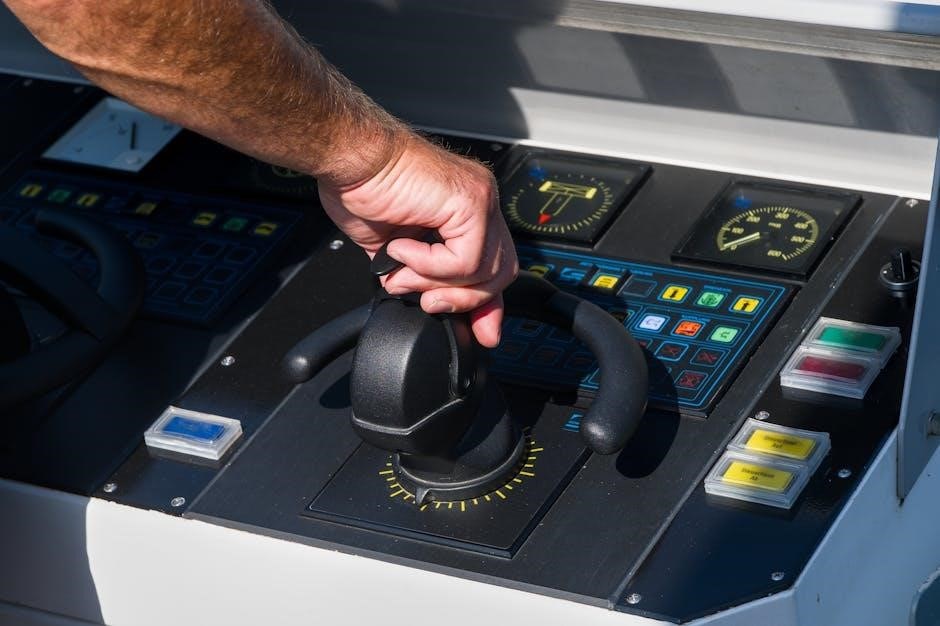The 2012 Honda Pilot Owners Manual is a comprehensive guide providing essential information on vehicle operation, maintenance, and troubleshooting. It serves as a permanent resource for owners, ensuring optimal performance and longevity. The manual covers all model specifics and is available online for easy access and reference.
Overview of the Manual’s Purpose and Structure
The 2012 Honda Pilot Owners Manual is designed to provide clear, concise information for optimal vehicle operation and maintenance. Structured for easy navigation, it includes sections on features, maintenance schedules, and troubleshooting. The manual covers essential topics like exterior and interior features, engine specifications, and safety systems. It also offers practical advice for DIY maintenance and addressing common issues. Available in both digital and print formats, the manual is formatted for printing or online reference. It serves as a permanent resource for owners, ensuring they can maximize their vehicle’s performance and longevity. Detailed and user-friendly, it is an indispensable guide for Pilot owners.
Key Features and Updates Specific to the 2012 Model
The 2012 Honda Pilot owners manual highlights key features and updates specific to the model year. It includes detailed information about the vehicle’s advanced technology, safety systems, and performance enhancements. The manual introduces updates such as improved fuel efficiency, enhanced interior comfort, and upgraded infotainment systems. It also covers the introduction of new exterior design elements and mechanical improvements. The manual serves as a guide to understanding these updates, ensuring owners can fully utilize the vehicle’s capabilities. By focusing on model-specific details, the manual provides tailored information to help owners maintain and enjoy their 2012 Honda Pilot effectively.

Vehicle Features and Specifications
The 2012 Honda Pilot boasts a robust 3.5L V6 engine, offering 250 horsepower and 253 lb-ft of torque. It features a 5-speed automatic transmission, seating for up to 8 passengers, and ample cargo space. The SUV includes a tow package capable of towing up to 4,500 pounds. Other specs include a 21-gallon fuel tank and EPA ratings of 17 MPG city and 23 MPG highway. These features make it a versatile choice for families and adventurers alike.
Exterior Features and Design Elements
The 2012 Honda Pilot features a rugged yet refined exterior design with a boxy silhouette, emphasizing functionality and durability. Its front grille is accented with chrome, complemented by projector-beam halogen headlights for enhanced visibility. The Pilot rides on 17-inch aluminum alloy wheels, offering a balance of style and performance. Roof rails come standard, providing additional storage options, while the rear includes a power tailgate with a lift-up glass hatch for easy access. The exterior is built with a combination of steel and lightweight materials, ensuring strength and fuel efficiency. Available in multiple paint options, the Pilot’s exterior is both practical and visually appealing, catering to families and outdoor enthusiasts alike.
Interior Features and Technology
The 2012 Honda Pilot offers a spacious and functional interior designed for comfort and convenience. It seats up to eight passengers, with optional second-row captain’s chairs reducing capacity to seven. The cabin features a tri-zone automatic climate control system, ensuring personalized comfort for all occupants. The dashboard includes a 6.1-inch touchscreen display for navigation, audio, and Bluetooth connectivity. A rear entertainment system with a 9-inch screen is available for rear passengers. Storage is abundant, with cupholders, pockets, and a large center console. The interior is trimmed with durable materials, and optional leather upholstery adds a premium touch. Built-in USB and auxiliary ports cater to modern tech needs, making the Pilot a versatile choice for families and long drives.
Engine and Performance Specifications

The 2012 Honda Pilot is powered by a 3.5-liter V6 engine, delivering 250 horsepower at 5,700 rpm and 253 lb-ft of torque at 4,800 rpm. This engine features a single overhead camshaft (SOHC) design with 24 valves and Variable Cylinder Management (VCM) technology, which improves fuel efficiency by deactivating cylinders during low-load driving conditions. Paired with a 5-speed automatic transmission, the Pilot offers smooth acceleration and responsive performance. Available in both front-wheel drive (FWD) and all-wheel drive (AWD) configurations, it provides excellent traction and control. With a towing capacity of up to 4,500 pounds, the Pilot is versatile for family needs or outdoor adventures.
Safety Features and Ratings
The 2012 Honda Pilot prioritizes safety with its robust ACE™ (Advanced Compatibility Engineering) body structure, designed to enhance collision energy absorption. It features a comprehensive array of airbags, including dual front, front side, and three-row side curtain airbags, ensuring protection for all occupants. The Pilot also includes electronic stability control and anti-lock braking system (ABS) for improved vehicle control. It received a Top Safety Pick rating from the Insurance Institute for Highway Safety (IIHS) and a 5-star overall safety rating from the National Highway Traffic Safety Administration (NHTSA). These ratings highlight its commitment to occupant protection and reliability, making it a trusted choice for families.
Fuel Efficiency and Environmental Impact
The 2012 Honda Pilot offers respectable fuel efficiency for its class, with an EPA rating of up to 17 mpg city and 23 mpg highway, depending on drivetrain configuration. The 3.5L V6 engine features Variable Cylinder Management™ (VCM), which deactivates cylinders during light driving to improve efficiency. The Pilot also meets stringent ULEV-2 emissions standards, reducing its environmental footprint. Proper tire pressure and regular maintenance can further optimize fuel economy. While not the most fuel-efficient SUV, the Pilot balances performance and practicality, making it a viable choice for eco-conscious drivers seeking a reliable family vehicle.

Maintenance and Care
Regular maintenance is crucial for the 2012 Honda Pilot to ensure optimal performance, safety, and longevity. Routine checks include oil changes, tire pressure monitoring, and fluid inspections.
Recommended Maintenance Schedule
The 2012 Honda Pilot requires regular maintenance to maintain reliability and performance. The recommended schedule includes oil changes every 5,000 to 7,500 miles, tire rotations every 7,500 miles, and brake inspections every 15,000 miles. Fluid checks, air filter replacements, and belt inspections are also essential at specified intervals. The owner’s manual provides a detailed timeline for these services, ensuring the vehicle operates efficiently. Adhering to this schedule helps prevent mechanical issues, reduces repair costs, and extends the vehicle’s lifespan. Neglecting maintenance can lead to premature wear and potential breakdowns, making it crucial to follow Honda’s guidelines for optimal performance and safety. Always refer to the manual for specific recommendations tailored to your driving conditions. Proper care ensures your Pilot remains reliable for years to come.
DIY Maintenance Tips for Owners
Owners of the 2012 Honda Pilot can perform several DIY maintenance tasks to keep their vehicle in top condition. Regular oil changes are straightforward and can be done at home with the right tools. Checking and maintaining proper tire pressure improves fuel efficiency and handling. Replacing the air filter is simple and can enhance engine performance. Owners can also inspect and top off windshield washer fluid, coolant, and brake fluid levels. Additionally, checking the condition of belts and hoses for cracks or wear can help prevent unexpected repairs. These tasks are cost-effective and empower owners to take an active role in maintaining their vehicle’s health. Always refer to the manual for specific instructions and safety guidelines when performing DIY maintenance. Regular inspections and basic upkeep ensure the Pilot runs smoothly and reliably. This approach fosters a deeper connection between the owner and their vehicle, promoting long-term satisfaction and performance. DIY maintenance not only saves money but also builds confidence in caring for your Honda Pilot. By following these tips, owners can enjoy a safer and more efficient driving experience. Proper care ensures the vehicle remains dependable for years to come.
Common Issues and Troubleshooting
The 2012 Honda Pilot may experience issues such as transmission slipping, faulty fuel sensors, or electrical system glitches. Transmission problems often manifest as hesitation or rough shifting, which can be diagnosed using the ODB-II scanner. Fuel sensor issues may cause inaccurate fuel level readings, requiring replacement. Electrical problems, like malfunctioning dashboard lights, can stem from loose connections or faulty fuses. For troubleshooting, owners should consult the manual for guidance on identifying symptoms and potential fixes. Simple solutions, such as resetting the ECU or replacing fuses, can resolve some issues. If problems persist, professional assistance is recommended to avoid further damage. Regular maintenance can prevent many of these common issues. Troubleshooting early ensures safety and extends the vehicle’s lifespan. Always refer to the manual for detailed instructions and safety precautions. Addressing issues promptly helps maintain the Pilot’s reliability and performance. Owners are encouraged to stay proactive in monitoring their vehicle’s condition. This approach minimizes downtime and ensures a smooth driving experience. By understanding common problems and their solutions, owners can better care for their Honda Pilot. Troubleshooting is a key part of responsible vehicle ownership. Taking these steps ensures the Pilot remains a dependable choice for years to come. Regular checks and timely repairs are essential for maintaining optimal performance. The manual provides a comprehensive guide to help owners address and resolve common issues effectively.

Importance of Regular Servicing
Importance of Regular Servicing
Regular servicing is crucial for maintaining the performance, reliability, and longevity of your 2012 Honda Pilot. It ensures that all systems operate efficiently, reducing the risk of mechanical failures. Routine checks, such as oil changes, tire rotations, and brake inspections, help prevent wear and tear. Servicing also improves fuel efficiency and reduces emissions, contributing to environmental sustainability. Additionally, regular maintenance enhances safety by addressing potential issues before they escalate. Following the recommended service schedule in the manual ensures compliance with manufacturer standards, preserving the vehicle’s value. Neglecting servicing can lead to costly repairs and compromised performance. Consistent care ensures your Honda Pilot remains dependable and performs optimally. Regular servicing is an investment in the vehicle’s health and your driving experience.

Operating the Vehicle
Operating your 2012 Honda Pilot safely and efficiently requires understanding its systems and controls. Familiarize yourself with the instrument panel, steering wheel functions, and pedal layout. Always wear a seatbelt and ensure all passengers do the same. Adjust mirrors and seats for optimal comfort and visibility. Start the engine, check surroundings, and proceed smoothly. Use turn signals for lane changes and obey traffic laws. Monitor fuel levels, temperature, and other vital indicators. Practice defensive driving to enhance safety on the road. Regular practice improves handling and confidence behind the wheel.
Starting and Driving the Vehicle
To start the 2012 Honda Pilot, insert the key into the ignition, turn it to the “ON” position, and press the start button. Ensure all occupants are buckled up. Check your surroundings, mirrors, and blind spots before moving. Gradually release the brake and accelerate smoothly. Use the steering wheel and pedals with care, maintaining a safe speed. Avoid sudden acceleration or hard braking. Shift gears appropriately for road conditions using the automatic transmission. Engage the parking brake on inclines or when stationary. Monitor the instrument panel for alerts and adjust settings as needed. Always follow traffic laws and drive defensively for safety.
Transmission and Gear Shift Operations
The 2012 Honda Pilot features a smooth 5-speed automatic transmission designed for responsive performance. To operate, shift the gear selector into “D” for normal driving. Use “L” for uphill climbs or towing to maintain lower gears. Avoid sudden shifts between gears, especially at high speeds; Always come to a complete stop before shifting into “R” or “P.” For manual control, use the steering wheel-mounted paddle shifters to adjust gears. When towing, use the “D” mode but avoid frequent shifting. Ensure the vehicle is stationary before shifting to “P” or “R.” Proper gear operation ensures optimal performance and extends transmission life.
Handling Different Driving Conditions
The 2012 Honda Pilot is designed to handle various driving conditions effectively. For urban driving, maintain a steady speed and use gentle acceleration. On highways, engage cruise control for fuel efficiency and reduced fatigue. In inclement weather, reduce speed and increase following distance. Activate the Vehicle Stability Assist (VSA) to enhance traction. For off-road driving, use the “VTM-4” mode for improved four-wheel-drive performance. Avoid sudden turns and maintain moderate speeds. In snowy or icy conditions, enable winter mode and use chains if necessary. Always adjust driving habits to match road conditions for safety and optimal performance.
Using the Parking Brake and Safety Features
To ensure safety, always engage the parking brake on inclines or when parked. Pull the lever fully upward and confirm it is secure. For added safety, shift the transmission to Park (automatic) or first gear (manual). The 2012 Honda Pilot features advanced safety systems, including Anti-lock Braking System (ABS), Electronic Brake Distribution (EBD), and Vehicle Stability Assist (VSA). These systems enhance control during hard braking or slippery conditions. The rearview camera provides visibility when reversing, helping to prevent accidents. Always wear seat belts and ensure all passengers do the same. Familiarize yourself with these features to maximize safety and control while driving.

Troubleshooting Common Problems
Troubleshooting common problems in the 2012 Honda Pilot involves identifying issues like warning lights or unusual noises. The manual provides diagnostic guides and repair solutions, ensuring drivers can address malfunctions effectively and safely.
Using the Manual for Diagnostic Purposes
The 2012 Honda Pilot Owners Manual serves as an essential diagnostic tool, helping owners identify and address potential issues. It provides detailed descriptions of warning lights, error codes, and symptoms, guiding users through troubleshooting processes. The manual includes step-by-step instructions for checking fluid levels, battery health, and other critical systems. By referencing the manual, drivers can pinpoint problems like unusual noises, reduced performance, or electrical malfunctions. It also offers advice on when to consult a professional, ensuring safety and preventing further damage. Regularly reviewing the manual helps owners stay proactive about maintenance and repairs, keeping their vehicle in optimal condition.
Understanding Dashboard Warning Lights
The 2012 Honda Pilot Owners Manual provides a comprehensive guide to understanding dashboard warning lights, ensuring driver awareness and safety. These lights indicate various vehicle conditions, from maintenance needs to critical system issues. Common lights include the oil pressure warning, battery alert, and brake system indicator. The manual details each light’s meaning, helping owners identify whether immediate action is required. It also explains how to respond safely, such as pulling over or scheduling a service. By familiarizing yourself with these symbols and their implications, you can address potential issues early, preventing more severe problems and maintaining your vehicle’s reliability and performance.
Addressing Common Electrical Issues
The 2012 Honda Pilot Owners Manual provides guidance for diagnosing and resolving common electrical issues. These may include blown fuses, dead batteries, or malfunctioning sensors. The manual outlines steps to identify the source of the problem, such as checking the fuse box or testing battery connections. It also covers resetting systems like the Electronic Throttle Control or VSA. Owners are advised to consult the manual for specific procedures to avoid further damage. For complex issues, professional assistance is recommended to ensure proper repairs and maintain the vehicle’s electrical systems in optimal condition. Regular inspections can help prevent such problems from arising.

Legal and Documentation
The 2012 Honda Pilot Owners Manual serves as a legal document, outlining warranty terms, regulatory compliance, and intellectual property rights. It ensures owners understand their legal obligations.
The Manual as a Legal Document
The 2012 Honda Pilot Owners Manual is a legal document that outlines the terms of the vehicle’s warranty, intellectual property rights, and regulatory compliance. It serves as a binding agreement between Honda and the vehicle owner, detailing the manufacturer’s responsibilities and the owner’s obligations. The manual also provides disclaimers regarding modifications, misuse, and liability, ensuring owners understand their legal rights and limitations. By adhering to the manual’s guidelines, owners can maintain compliance with local laws and regulations, while also preserving their warranty coverage. This document is essential for understanding the legal framework surrounding the vehicle’s ownership and operation.
Understanding Warranty Information
The 2012 Honda Pilot Owners Manual includes detailed warranty information to help owners understand their coverage. The manual outlines the New Vehicle Limited Warranty, which covers repairs for parts and labor due to defects in materials or workmanship for a specified period or mileage. It also explains the powertrain warranty, which provides extended protection for key components. The manual lists exclusions, such as damage from misuse or unauthorized modifications, and emphasizes the importance of following the recommended maintenance schedule to maintain warranty validity. Understanding this section ensures owners can make informed decisions about repairs and maintenance, maximizing their warranty benefits.

Downloading and Accessing the Manual
The 2012 Honda Pilot Owners Manual can be conveniently accessed online through Honda’s official website or authorized dealerships. Owners can download the PDF version for free, ensuring easy access to essential information anytime, anywhere. This digital format allows for easy searching and reference, making it a practical resource for vehicle maintenance and operation. Additionally, the manual can be printed or saved on personal devices for offline use, providing flexibility and convenience for owners to stay informed about their vehicle’s care and functionality.
Where to Find the Manual Online
The 2012 Honda Pilot Owners Manual is readily available online through Honda’s official website at https://owners.honda.com. Owners can visit this site, select their vehicle’s model year (2012) and specific trim to access the manual. Additionally, authorized Honda dealerships often provide direct links or downloadable versions of the manual. Some third-party automotive websites may also host the manual, though it’s important to verify the source for accuracy. Ensuring you download from a trusted site guarantees you receive the correct and up-to-date information tailored to your vehicle. This convenient access allows owners to reference the manual anytime, without needing a physical copy.
How to Download the PDF Version
To download the 2012 Honda Pilot Owners Manual in PDF format, visit Honda’s official website at https://owners.honda.com. Log in or create an account if prompted, then select the “Manuals & Guides” section. Choose the 2012 Pilot from the model year dropdown and click on the appropriate trim level. Locate the “Download” option to save the PDF directly to your device. Ensure your browser allows pop-ups and has sufficient storage space. Some third-party websites may also offer the PDF, but verify their reliability before downloading. Once downloaded, you can easily access the manual offline or print specific sections as needed for convenience.
Printing and Binding the Manual
Printing the 2012 Honda Pilot Owners Manual in PDF format allows for easy customization. Use a high-quality printer to ensure clear text and diagrams. Print on standard 8.5×11-inch paper for compatibility with most binders. Consider using a local print shop for professional-grade printing. For binding, options include comb, spiral, or 3-ring binders. Punch holes in the printed pages and organize them logically, separating sections like maintenance schedules or troubleshooting guides. Adding clear covers or cardstock dividers can enhance durability and readability. Store the printed manual in your vehicle or garage for quick reference. This ensures you always have a physical copy handy, even without digital access.
The 2012 Honda Pilot Owners Manual serves as a comprehensive guide, ensuring optimal performance, safety, and longevity of your vehicle. Referencing it regularly maximizes your driving experience and maintains your SUV in prime condition year-round.
Final Thoughts on the Importance of the Manual

The 2012 Honda Pilot Owners Manual is an indispensable resource for ensuring optimal vehicle performance, safety, and longevity. It provides detailed guidance on operating, maintaining, and troubleshooting your SUV, empowering owners with the knowledge to make informed decisions. By following the manual’s recommendations, drivers can enhance fuel efficiency, prevent potential issues, and ensure compliance with safety standards. Regularly consulting the manual fosters a deeper understanding of the vehicle’s features and capabilities, promoting a safer and more enjoyable driving experience. Ultimately, it serves as a vital tool for preserving the value and reliability of your Honda Pilot for years to come.

Be First to Comment